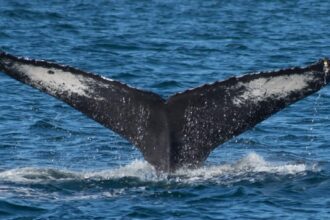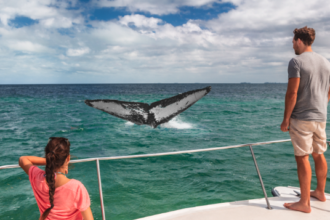What Kind of Whales Are in Banderas Bay
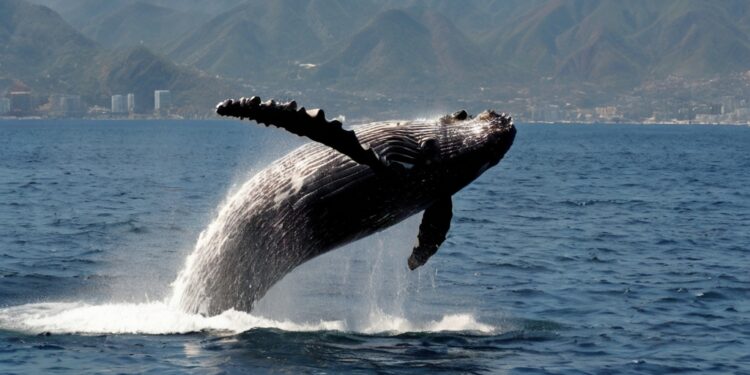
Banderas Bay welcomes around 700 magnificent humpback whales each year. These giants swim nearly 5,000 kilometers from the west coast of Canada and the United States. The massive marine mammals can grow up to 60 feet long and weigh up to 40 tons, and they choose these warm Mexican waters to mate, give birth, and care for their young.
Puerto Vallarta’s whale watching season runs from mid-December to March. Visitors can watch these gentle giants swim and play in their natural habitat. The bay transforms into a nursery where newborn calves, weighing up to 1,500 pounds and stretching 15 feet, take their first breaths. Scientists have tracked over 1,300 different humpback whales in Banderas Bay since the late 1980s, making this area one of Mexico’s prime whale watching spots.
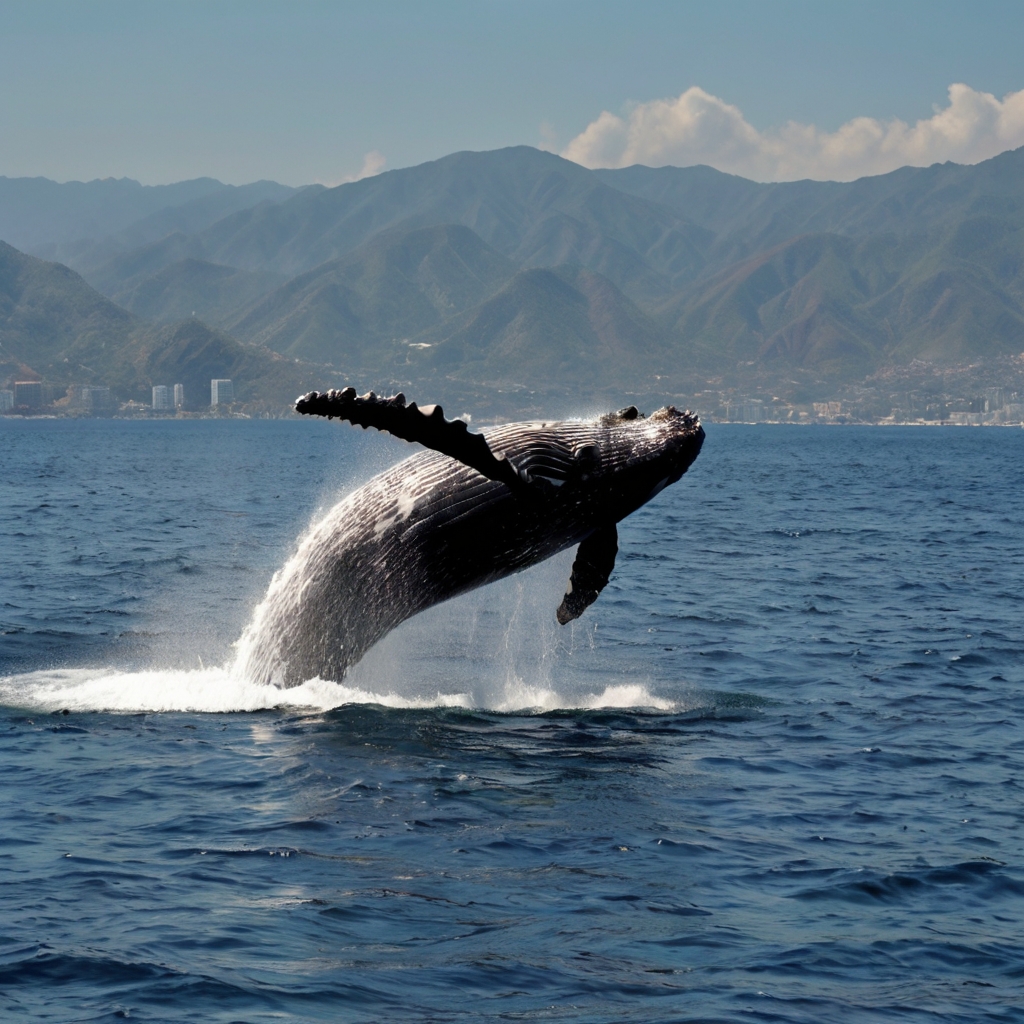
Table of Contents
- 1 Complete Guide to Whale Species in Banderas Bay
- 2 Best Time to See Whales in Puerto Vallarta [2025 Season]
- 3 Top Whale Watching Spots in Banderas Bay
- 4 Expert Tips for Whale Watching Success
- 5 Responsible Whale Watching Guidelines
- 6 Here are some FAQs about what kind of whales are in Banderas Bay:
- 6.1 Are there killer whales in Banderas Bay?
- 6.2 What kind of whales are in Puerto Vallarta right now?
- 6.3 How many whales come to Banderas Bay?
- 6.4 Why do humpback whales come to Puerto Vallarta?
- 6.5 Are there dolphins in the Bay of Banderas?
- 6.6 Where are you most likely to see a killer whale?
- 6.7 What is the best month for whale watching in Puerto Vallarta?
- 6.8 Are there sharks off the coast of Puerto Vallarta?
- 6.9 Can you see whales from the shore in Puerto Vallarta?
Complete Guide to Whale Species in Banderas Bay
Banderas Bay is a protected marine sanctuary that hosts several magnificent cetacean species year-round. The Mexican Government made this area a marine protected zone to conserve its whale populations.
Magnificent Humpback Whales: The Star Attraction
These gentle giants rule the bay’s waters, reaching 14-17 meters in length and weighing about 35 tons. Each year, 500-700 humpback whales visit Banderas Bay to mate and raise their young. You can spot them by their distinctive body shape and small fin that looks like a hump. These social creatures usually travel alone or in small pods of two to three whales and can live 50-80 years.
Rare Bryde’s Whale Sightings
Bryde’s Whales make Banderas Bay their home. These remarkable creatures are as big as humpbacks but stand out with their two blowholes and tendency to travel in pairs. They spend their lives in tropical waters, unlike other whale species, making them true natives of warm marine environments.
Other Marine Mammals You Might Encounter
The bay’s rich biodiversity has an impressive collection of marine mammals. Scientists have documented about 13 cetacean species that regularly appear in these waters. Visitors might spot:
- Bottlenose dolphins (~1000 sightings)
- Pantropical spotted dolphins (~1000 sightings)
- Dwarf sperm whales (~100 sightings)
- Rough-toothed dolphins (~100 sightings)
- Bryde’s whales (~30 sightings)
- Gray whales (~30 sightings)
Killer whales and false killer whales sometimes visit these waters. They’re known to be friendly and often approach boats. Giant manta rays also grace these waters, stretching up to 20 feet wide. The bay’s unique location, where several biogeographic areas meet, creates an exceptional marine environment that supports this remarkable cetacean diversity.
Best Time to See Whales in Puerto Vallarta [2025 Season]
The best time to watch whales in Banderas Bay starts December 8th and runs through March 23rd. This regulated timeframe will give a perfect balance between great viewing chances and protecting these amazing creatures.
Peak Season Month-by-Month Guide
Whale activity follows a clear pattern throughout the season:
- December: First whales show up, and you’ll definitely see them from December 20th
- January: Activity reaches its peak with about 7.7 whales per hour
- February: Strong presence continues with 4.9 whales per hour
- March: Whales start leaving, showing 3.6 whales per hour
January and February are the best months to see these marine mammals at their most active.
Optimal Viewing Times and Weather Conditions
Tours start around 8:30 AM and give the best viewing conditions. The early hours have calmer seas and better visibility. Another tour leaves at 1:00 PM, but the sea can be a bit rougher.
Morning’s light creates amazing photo opportunities as the sun lights up the whales’ spectacular breaching against the sparkling water. The cool temperatures and calm waters help reduce seasickness among visitors.
Migration Patterns and Behavior Changes
A study covering 14 breeding seasons (2004-2017) reveals some interesting changes in whale behavior. Scientists tracked 8,013 whales during 1,394.6 navigation hours. The peak numbers now come earlier, with December and January showing higher numbers than February and March.
These smart creatures swim about 6,000 miles from the Northern Pacific and Bering Sea to reach these warm waters. They come here to mate, give birth, and nurse their young. The whales don’t eat during their Puerto Vallarta stay and live off fat stores from their summer feeding in northern waters.
New studies show North Pacific humpback whale numbers keep growing, and they’re arriving earlier to their winter spots. This change might show how well they adapt to shifting global climate patterns.
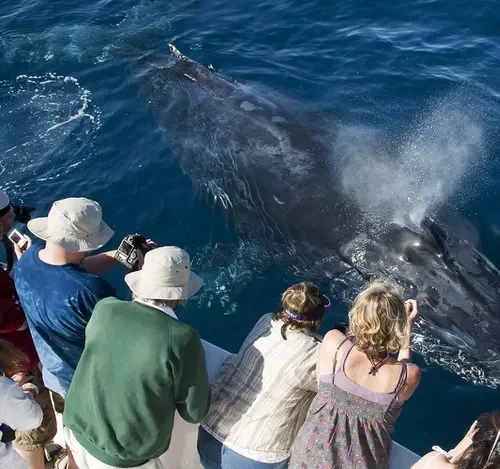
Top Whale Watching Spots in Banderas Bay
Banderas Bay stretches along Puerto Vallarta and Nayarit’s pristine coastlines, providing amazing spots to watch majestic marine life. Each location, from busy marinas to quiet beaches, gives whale enthusiasts a chance to spot these magnificent creatures.
Prime Viewing Locations from Puerto Vallarta
Marina Vallarta serves as the starting point for whale watching tours that depart at 8:30 AM and 1:00 PM. Whales frequently appear in the waters between the Marietas Islands and Puerto Vallarta. The area sits at the meeting point of the North Pacific Ocean and the Sea of Cortez, creating perfect conditions to observe marine life.
Hidden Gems in Nayarit Waters
Punta de Mita stands out as an exclusive spot with its stunning views of Banderas Bay and the Marietas Islands. Sayulita’s special location makes it a fantastic place to watch whales as it sits where major marine migration routes meet. Visitors can experience close encounters with various species near Nayarit’s coast. Some lucky observers have spotted sperm whales just a kilometer from Sayulita’s beach.
Shore-Based Observation Points
Land-based whale watching enthusiasts have several excellent spots to choose from. Puerto Vallarta’s Malecón offers sweeping views of the bay where visitors can spot breaching whales with binoculars. Experienced observers recommend looking for these signs from shore:
- Groups of boats gathered in one area often mean whales are nearby
- Sunlight catches water plumes from blowholes
- Tail flukes above the surface show diving behavior
The infinity pool at Armony Luxury Resort & Spa in Punta de Mita provides a great spot to watch whales while overlooking the Marietas Islands. Families at Marival Emotions Resort’s beach often see humpbacks swimming close to shore. The rooftop Insú Sky Bar at Marival Distinct Luxury Residences combines whale watching with upscale amenities.
Expert Tips for Whale Watching Success
The right whale watching experience in Puerto Vallarta depends on several key factors that will give a memorable encounter with these majestic creatures.
Choosing the Right Tour Operator
Adult tickets from certified whale watching companies in Puerto Vallarta cost around USD 87, while children’s tickets are USD 77. The price shouldn’t be your only factor. Look for operators with the official orange flag that indicates proper authorization from Mexican authorities. Vallarta Adventures, a well-known company, offers specialized whale watching schedules with a focus on small group experiences.
Wildlife Connection makes their tours accessible to guests with physical, visual, or hearing disabilities. Eco Explorer Vallarta runs private tours for groups of 6-10 people at USD 570. Ecotours Vallarta brings 25 years of expertise to their whale watching trips.
Photography and Video Tips
You need good preparation to capture these magnificent creatures. A telephoto lens between 70 to 200mm works best according to professional photographers. Your mobile phone’s burst mode or Live settings can help you get great shots since whales surface without warning.
Morning light creates perfect conditions to photograph breaching whales against the sparkling water. The experienced guides know whale behavior patterns and can help you prepare for that perfect shot.
What to Bring and Wear
Your comfort and safety matter most during whale watching trips. Here’s what you need:
- Non-slip, waterproof shoes to stay stable
- Light, waterproof jacket
- UV-protective sunglasses and wide-brimmed hat
- Biodegradable sunscreen
- Camera equipment and binoculars
Seasickness prevention needs attention. Take motion sickness medication the night before and again just before the tour – this is what experienced captains suggest. You should arrive 45 minutes before departure to handle check-in and orientation smoothly.
Layered clothing works best for changing weather conditions. The sea temperature drops 10-15 degrees compared to the shore. You’ll need waterproof clothing since sea spray is common during these exciting encounters.
Responsible Whale Watching Guidelines
Mexican authorities have created complete guidelines that protect the majestic whales in Banderas Bay’s waters. The NOM-131-SEMARNAT-2010 stands as the life-blood of whale watching regulations. These rules ensure marine mammals stay protected during their yearly visits.
Understanding Mexican Regulations
SEMARNAT (Secretariat of Environment and Natural Resources) requires all whale watching operators to get official permits. Certified operators must display an orange whale watching flag during their excursions to prove their authorization. More than 400 tour operators took part in mandatory training sessions for the 2024-2025 season, showing their dedication to conservation.
Safe Viewing Distances and Practices
Specific distance requirements exist based on vessel size:
- Small boats (under 10 meters): Must maintain 60 meters distance
- Medium and large vessels (over 10 meters): Required to keep 80 meters away
- Boats without permits: Must stay 800 feet from whales
- Maximum of 4 boats allowed around any whale or group
Operators must follow strict behavioral guidelines beyond these distances. Vessels should keep speeds below 9 km/hr (5 knots). Safety protocols prohibit sudden acceleration or direction changes within 300 meters of whales.
The quickest way to approach involves moving from the side and slightly behind the whales, never from the front or in an encircling manner. Mother whales with calves need extra protection, demanding heightened caution during observation.
Supporting Conservation Efforts
Mexico’s steadfast dedication to whale conservation began in 1972 with the world’s first marine protected area specifically for cetaceans. Several initiatives now support ongoing conservation:
The Nado por las Ballenas (Swim for the Whales) project wants to raise over one million pesos for significant conservation actions. These funds support:
- Whale-watching surveillance programs
- Retrieval of abandoned fishing nets
- Rescue operations for entangled whales
- Coral cultivation in the Marietas Islands National Park
- Environmental education in local schools
Rules prohibit swimming, snorkeling, jet skiing, or scuba diving near whales. Fishing operations must stop in areas where whales appear. These measures have helped Mexico become one of the world’s top ten tourism destinations for whale watching, second only to the United States in popularity.
Banderas Bay ranks among Mexico’s finest destinations for whale watching and provides visitors amazing encounters with these magnificent marine mammals. The area combines strict conservation measures with professional tour operators. Natural beauty creates ideal conditions to observe humpback whales and other cetacean species.
Careful planning and respect for these gentle giants drive Puerto Vallarta’s whale watching success. The regulated season runs from December to March and gives visitors the best viewing opportunities. This timing protects these incredible creatures during their significant breeding period.
Visitors can witness the awe-inspiring spectacle of whales in their natural habitat through certified boat tours or shore viewing. The bay’s strategic location, complete guidelines, and focused conservation work make sure these majestic creatures will grace these waters for future generations.
Here are some FAQs about what kind of whales are in Banderas Bay:
Are there killer whales in Banderas Bay?
Yes, killer whales can occasionally be spotted in Banderas Bay, but sightings are rare. They are not as commonly seen as humpback whales, which are the primary attraction for whale watching in Puerto Vallarta and Nayarit. These transient killer whales sometimes pass through the area during migration, adding to the diversity of marine life in the bay.
What kind of whales are in Puerto Vallarta right now?
The most common whales in Puerto Vallarta during the season are humpback whales. Other species, such as Bryde’s whales, can also be seen occasionally. Whale watching in Puerto Vallarta offers visitors a chance to witness these majestic creatures in their natural habitat.
How many whales come to Banderas Bay?
Hundreds of humpback whales migrate to Banderas Bay every season. This migration is part of their journey to the warm waters of Mexico, where they mate and give birth. Whale watching in Nayarit and Puerto Vallarta provides a unique opportunity to observe these whales during their annual visit.
Why do humpback whales come to Puerto Vallarta?
Humpback whales come to Puerto Vallarta for its warm and shallow waters, which are ideal for mating and giving birth. Banderas Bay offers a safe environment for newborn calves and breeding adults. This makes whale watching in Puerto Vallarta one of the most exciting activities during the migration season.
Are there dolphins in the Bay of Banderas?
Yes, dolphins are frequently seen in the Bay of Banderas. Common species include bottlenose dolphins and spinner dolphins. Alongside whales, dolphins are a highlight of whale watching in Nayarit and Puerto Vallarta, making the bay a hotspot for marine life enthusiasts.
Where are you most likely to see a killer whale?
Killer whales are most likely to be seen in colder waters, such as the Pacific Northwest or Arctic regions. However, transient pods can occasionally be spotted in the waters of Banderas Bay and other parts of Mexico. These sightings are rare but memorable for whale watchers.
What is the best month for whale watching in Puerto Vallarta?
The best months for whale watching in Puerto Vallarta are December through March. This is when the humpback whale migration is at its peak, and visitors can see them in Banderas Bay. Whale watching in Puerto Vallarta during this time offers incredible views of these magnificent creatures.
Are there sharks off the coast of Puerto Vallarta?
Sharks do inhabit the waters off the coast of Puerto Vallarta, but sightings are infrequent, especially near tourist areas. Common species include nurse sharks and small reef sharks. These sharks pose little risk to humans and are not typically seen during whale watching in Puerto Vallarta.
Can you see whales from the shore in Puerto Vallarta?
Yes, it is possible to see whales from the shore in Puerto Vallarta, especially during the peak season from December to March. Scenic spots along Banderas Bay, such as Mirador de La Cruz, provide excellent vantage points for spotting whales in the distance. For a closer view, guided tours for whale watching in Puerto Vallarta are highly recommended.
